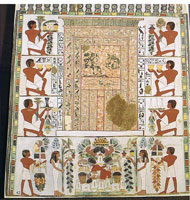“False doors”, also known as “Ka doors”, as they allowed the Ka (an element of the “soul”) to pass through them, were common in the mortuary temples and tombs of ancient Egypt from around the Third Dynasty and temples of the New Kingdom. The false door was thought to be a threshold between the world of mortals and the world of deities and spirits. The deity or the deceased could interact with the world of the living either by passing through the door or receiving offerings though it. As a result it was not uncommon to find false doors depicted on the sides of coffins as well as on the cabinets of “shawabti” ( or “ushabti” – magical servants).
During the New Kingdom false doors in temples were often associated with a chapel known as “the hearing ear” which was generally located in the outer wall near the back of the temple close to the sanctuary. These chapels allowed those outside the temple to communicate directly with the god who could hear them through the false door. However, the majority of false doors are to be found in tombs and mortuary temples to allow the deceased to access the living world and receive offerings. In fact, the false door can be seen as the combination of an offering niche and a stele with the offering formula inscribed on it.

The false door was placed on the west wall of the offering chamber (as the west was associated with death and the afterlife) at the back of the tomb or mortuary temple. It was not unusual for a tomb to contain two false doors. One for the owner of the tomb and the other for his wife. There are also a few examples within mastabas where each member of an extended family was given their own false door.

Although the false door was often composed of a single piece of fine limestone, they were often painted red with black speckles to resemble granite (e.g. the false door in the tomb of Seankhuiptah at Saqqara). Occasionally, the false door was made of wood (e.g. the tomb of Hesire) or was simply a design painted on the flat surface of an internal wall. Although the vast majority of false doors were fixed in position, and of purely symbolic nature, there are a few examples (such as that of Hesire) which had movable wooden panels.
Many false doors were modelled on the “palace facade” design found on the outside of Early Dynasty mastabas and on the outer wall of Djoser’s step pyramid. A typical false door has a long, narrow recessed panel which represented the actual doorway. Above this, a semi-cylindrical moulding represented the reed mat generally used to close a real door. The narrow panel and moulding are set inside a rectangular frame, often topped by a rectangular panel decorated with an image of the deceased sitting in front of an offering table. The offering table took the form of the “hotep” hieroglyph (a bread loaf on a reed mat representing an offering) and the offering formula was generally inscribed around him or her.

Outside this it was common for there to be an architrave (a rectangular frame). The false door was usually placed on a lintel (false or real) that extended across the door jambs and generally included up to three pairs of jambs leading to a central niche.
There was often an offering table in front of the false door on which offerings of food and drink were placed. The offering tables were usually made of stone and were often decorated with depictions of typical offerings (bread, beer, fowl, ox) and with depressions to receive offerings.



From the middle of the Fifth Dynasty, the decorations often included torus moulding (convex moulding resembling a semicircle in cross section) and a “cavetto cornice” (a concave bracket around the top of a wall or gate with a cross section that resembles a quarter circle in cross section). It is thought that these decorations represented the plants originally used to build predynastic buildings. Images of the deceased were also fairly common. Usually, the decoration was undertaken in such a manner that the deceased appeared to emerge from the false door itself.
Along with the name and titles of the deceased, and the offering formula, the decoration on the false door often included a curse to those who would harm the deceased and a blessing to those who made offerings. For example, the false door in the tomb of Redi-ness at Giza (G 5032) has the following text inscribed on it;
“Never did (I) do any evil thing against people. (As for) those who will do something against this, it shall be protected from them”.. (I) have constructed this my (tomb) with my own means. It is the god who will judge (my) case along with him who does anything against it.”
Bibliography
- Bard, Kathryn (2008) An introduction to the Archaeology of Ancient Egypt
- Dodson, Aiden (2016) The Royal Tombs of Ancient Egypt
- Redford Donald B (2002) Ancient Gods Speak
Copyright J Hill 2010